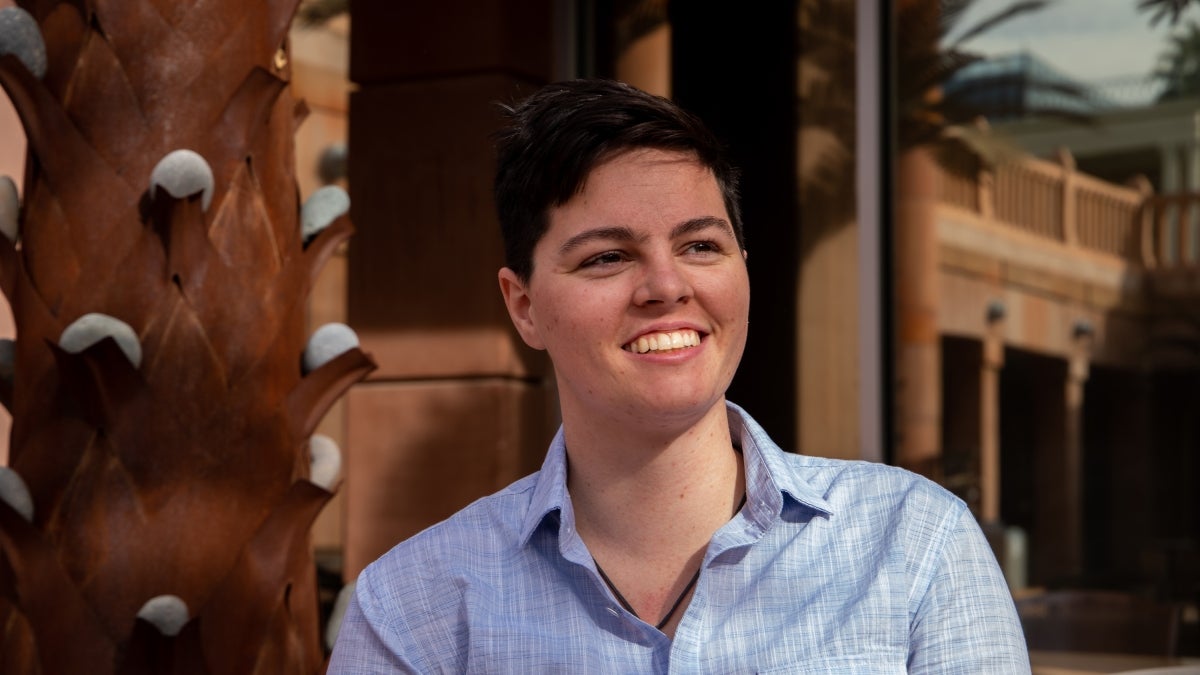Editor’s note: This is part of a series of profiles for fall 2019 commencement.
When a local concerned citizens; group reached out to an ASU professor and his research team of students on ways to better educate others on the issues surrounding helium extractions, Master of Science and Technology Policy graduate Katherine Ball knew she could help.
From that collaboration, an educational game developed. Helium Futures is a game centered around a fictional community facing helium extraction. The game, co-developed with No Fracking Arizona features the work of Ball, Assistant Professor Kirk Jalbert and his research group, the Civic Science for Environmental Futures Collaborative.
Ball found the project compelling and it became the basis of her thesis. The experience also changed how she viewed working with and running community engagement workshops.
"How do you run a workshop that's not about you telling them what they need to do or what they need to say? How do you get them down into what the actual major concerns are that are really behind this big public statement? That's how I'd like to do any work I'm doing long term."
The final product of the game was awarded honorable mention at the 2019 4S Making and Doing Festival in New Orleans. The festival is an exhibit of practitioners doing experimental works that engage approaches to the study of science and technology, with the intent of expanding modes of inquiry and creative collaboration in science and technology studies. From presenting at that festival, there is interest in using the game in environmental justice undergraduate courses.
In the sixth grade, Ball’s grandmother gave her a book on a famous oceanographer Curtis Ebbesmeyer and from that moment on, Ball knew she wanted to be on a boat studying plastics. That single goal led to the pursuit of an undergraduate degree in physical oceanography. But after completing her time at the University of Washington, Ball began to feel that policy is where she could make the most impact, not just out studying in the field.
"What I care about is working with communities on environmental policies that actually work for them," Ball said. "I think the federal government's where I'm going to make the biggest impact on how stuff is actually implemented at the local level."
Ball became interested in citizen science as a way to better engage with community groups on the issues facing them. She heard about the Citizen Science Maker Summit held at ASU In 2016. Its exploration of the cross-section of citizen science and the maker space was a large part of her undergrad thesis. While here, she learned about the School for the Future of Innovation in Society and its graduate programs. The MSTP program combined her three areas of interest with a faculty and culture that spoke to her.
“I love playing games and I've been like vaguely interested in like how do people learn from these," she said.
Her first semester, she took a class on educational game creation. "In that class, there came a moment where we were talking about what game we were going to make is our product and we had this moment. Wait like you don't have to tell someone a story for them to learn. They can tell you a story and still learn from it and that kind of became the theme of that game, another one I made and my master's thesis."
The process changed how Ball approaches community-engagement. "It's not necessarily what story can I tell you, but what is your story in this larger one? Which is just a new way of thinking about the work I'm interested in. Being more community-driven and community-engaged."
Question: What's the best piece of advice you'd give to those still in school?
Answer: ASU is so big, it is intimidating, but also you can literally make whatever you want out of it and the program will support that and help you guide or frame wherever you end up in the end when you have to develop an applied project. Whatever you've done up that point can become a thing, even if it doesn't feel like anything at the start.
Q: What are your plans after graduation?
A: I am pursuing my PhD in Human and Social Dimensions of Science and Technology at SFIS (School for the Future of Innovation in Society). After that, I want to work in a federal agency. My shortlist right now is Bureau of Ocean Energy Management, National Oceanic and Atmospheric Administration or Fish and Wildlife Service — all the ones that can do ocean environmental regulation.
Q: If someone gave you $40 million to solve one problem on our planet, what would you tackle?
A: I would use it to start a nonprofit idea that I've had since undergrad. STEM and STEAM education focuses on so much like K–12. I've talked to a lot of adults who are like, “I see my kids getting this. I wish I had this.” I didn't get this, so I've had this idea of a program that focuses on adults to get the chance to get that type of education.
More Science and technology

Will this antibiotic work? ASU scientists develop rapid bacterial tests
Bacteria multiply at an astonishing rate, sometimes doubling in number in under four minutes. Imagine a doctor faced with a…

ASU researcher part of team discovering ways to fight drug-resistant bacteria
A new study published in the Science Advances journal featuring Arizona State University researchers has found…

ASU student researchers get early, hands-on experience in engineering research
Using computer science to aid endangered species reintroduction, enhance software engineering education and improve semiconductor…
